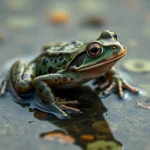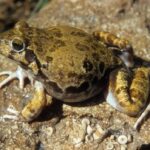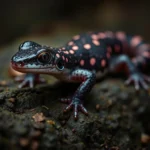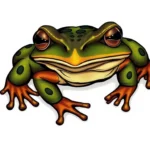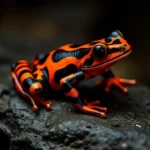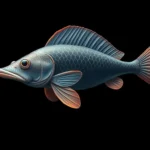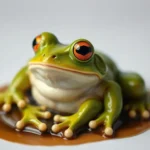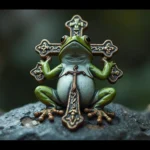The Green Frog: A Symbol of Transformation and Renewal
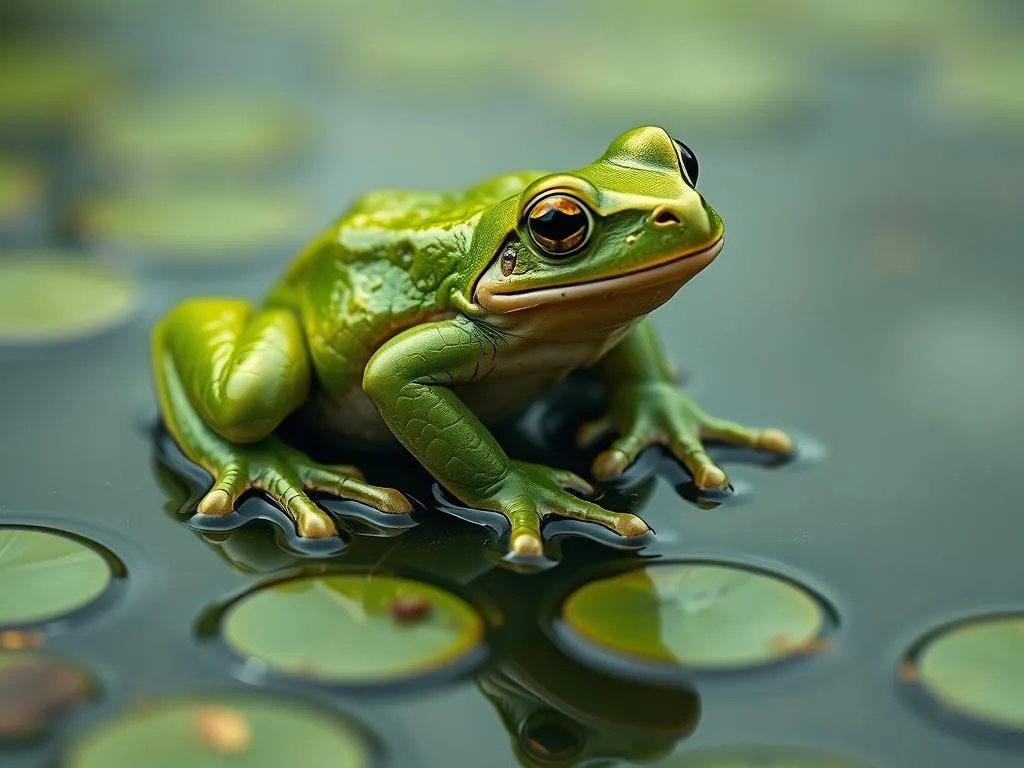
Disclaimer: Some images on this website are AI-generated artworks and may not accurately represent real animals.
Understanding the Green Frog
The green frog (Lithobates clamitans) is one of the most recognizable amphibians in North America. Known for its vibrant green coloration and distinctive vocalizations, this species thrives in a variety of freshwater habitats, making it a common sight near ponds, lakes, and marshes.
Physical Characteristics
When observing a green frog, its striking appearance is hard to miss. Below is a summary of its key physical traits:
| Trait | Description |
|---|---|
| Color | Bright green to olive green, often with dark spots |
| Size | Adults typically measure 2 to 4 inches in length |
| Skin Texture | Smooth, moist skin with a glossy appearance |
| Eyes | Prominent, bulging eyes that are usually gold or yellow |
| Limbs | Long, powerful hind legs suited for jumping and swimming |
These frogs are adept swimmers, often found basking on lily pads or the banks of their aquatic habitats. Their calls, a series of “quacks,” are a hallmark of warm summer nights, signaling both their presence and readiness to mate.
Lifecycle
The lifecycle of the green frog is a fascinating journey of transformation. It begins when female frogs lay clusters of eggs in water, which hatch into tadpoles. These tadpoles, primarily herbivorous, undergo a remarkable metamorphosis. Over several weeks, they develop legs, absorb their tails, and shift from a vegetarian diet to a more carnivorous one as adults.
This metamorphosis serves as a powerful symbol of change and growth. The transition from a tadpole to a frog encapsulates the essence of adaptability, reflecting the green frog’s ability to thrive in various environments, from still waters to flowing streams.
Ecological Role
In the ecosystem, the green frog plays a vital role. As both predator and prey, it helps maintain the balance of aquatic and terrestrial ecosystems. The green frog feeds on insects and other small invertebrates, controlling their populations and contributing to the health of its habitat. Conversely, it serves as a food source for larger animals, such as birds, snakes, and mammals, thereby supporting the food chain.
This duality in its role emphasizes the importance of the green frog in ecological balance, further enhancing its symbolism of transformation and renewal.
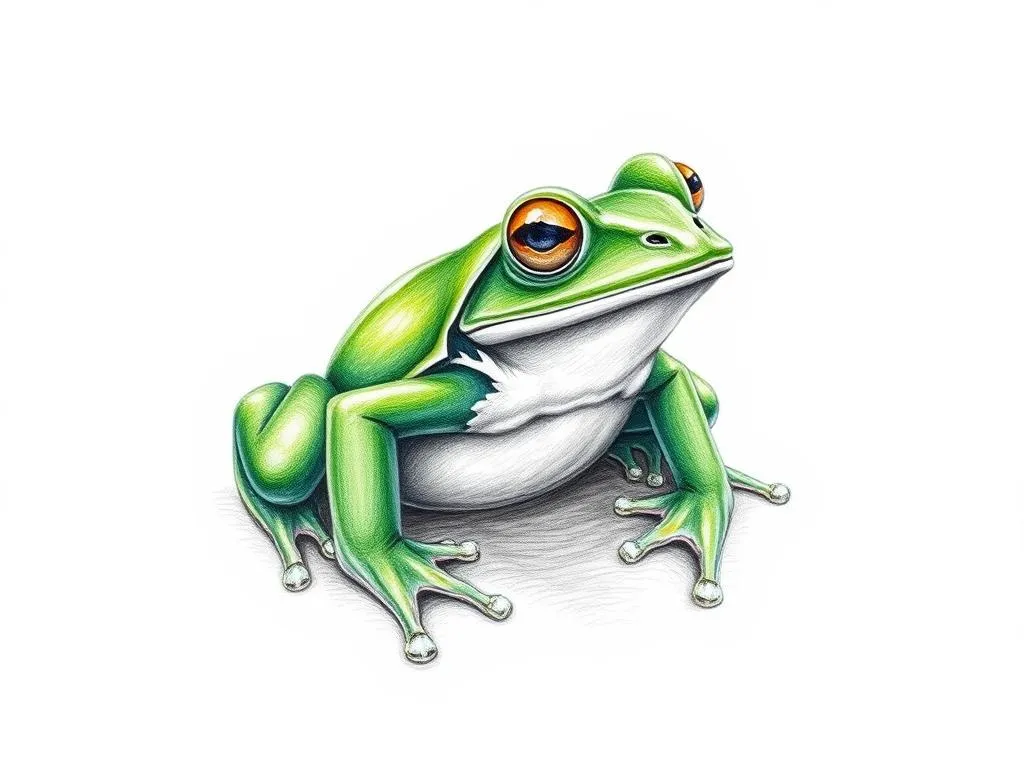
Symbolism & Spiritual Meaning
The green frog is not just a creature of nature; it holds profound symbolic and spiritual meanings that resonate with many people. Its journey from tadpole to adult frog reflects significant life themes that can inspire personal growth and transformation.
Transformation and Change
The green frog is often associated with transformation and change. This symbolism can be seen in various spiritual beliefs, where frogs represent the ability to adapt to new circumstances. The process of metamorphosis signifies the potential for personal growth, reminding us that change is a necessary part of life.
When one encounters or reflects upon the symbolism of the green frog, it may encourage them to embrace changes in their own life, fostering a mindset open to new experiences and opportunities.
Renewal and Rebirth
Water is an essential element in the life of a green frog, symbolizing renewal and rebirth. Frogs are often found in freshwater environments, making them natural symbols of cleansing and rejuvenation. This connection to water emphasizes the idea of emotional and spiritual healing.
In many cultures, water represents a source of life and renewal. The presence of the green frog serves as a reminder to cleanse oneself of negativity and embrace new beginnings. Whether through physical, emotional, or spiritual means, the green frog encourages individuals to seek renewal in their lives.
Adaptability
The green frog’s ability to thrive in various environments speaks to its adaptability. This trait symbolizes resilience and flexibility, qualities that are essential for navigating life’s challenges. The green frog’s presence encourages individuals to find strength in their adaptability, reminding them that they can overcome obstacles and flourish in changing circumstances.
In a world that is constantly evolving, the green frog stands as a testament to the power of resilience and the importance of embracing life’s transformations.
Green Frog in Dreams
Dreams often serve as a reflection of our subconscious thoughts and emotions. The appearance of a green frog in dreams can hold significant meaning, particularly related to themes of change and renewal.
Common Themes
When people dream about green frogs, several common themes may arise, each with its own interpretation. Below is a table that outlines these themes:
| Dream Theme | Interpretation |
|---|---|
| Change | Represents impending life changes or transitions |
| New Opportunities | Signals the arrival of new possibilities or paths |
| Emotional Healing | Indicates a need for introspection and healing |
These interpretations can provide valuable insights into the dreamer’s current situation, encouraging them to reflect on their emotions and experiences.
Personal Reflection
Dreaming of green frogs invites individuals to examine their lives closely. It encourages introspection, prompting one to consider the changes they may be undergoing or the opportunities that lie ahead. By analyzing the emotions and situations present in the dream, individuals can gain deeper insights into their personal journeys.
The symbolism of the green frog in dreams serves as a reminder to embrace change, recognize opportunities, and focus on emotional healing.
Cultural Significance and Folklore
Frogs, including the green frog, have held a prominent place in cultural narratives and folklore throughout history. Their unique characteristics and life cycles have inspired myths and stories across various societies.
Mythological Associations
In many cultures, frogs are seen as symbols of fertility, transformation, and rebirth. In ancient Egyptian mythology, the frog goddess Heket was associated with childbirth and fertility, symbolizing the transformative power of life. Similarly, Native American cultures often regarded the frog as a messenger of rain and abundance, linking it to the cycle of life and renewal.
These mythological associations highlight the green frog’s significance in understanding life’s mysteries and the natural world.
Symbolism in Art and Literature
The green frog has also made its mark in art and literature. From Aesop’s fables to contemporary poetry, frogs often appear as symbols of transformation and resilience. For instance, in literature, the frog is frequently portrayed as a character that undergoes significant change, mirroring the human experience of personal growth.
Artistic depictions of frogs often emphasize their vibrant colors and transformation, further solidifying their role as symbols of renewal and adaptability.
Modern Interpretations
As we navigate the modern world, the symbolism of the green frog continues to resonate with contemporary themes, particularly in environmental consciousness and personal empowerment.
Environmental Consciousness
In today’s context, the green frog serves as a powerful symbol of environmental awareness. As amphibians, frogs are sensitive indicators of ecosystem health, and their decline often signals larger environmental issues. By recognizing the importance of frogs in our ecosystems, we are reminded of our responsibility to protect natural habitats and promote conservation efforts.
The green frog acts as a call to action, urging individuals to become stewards of the environment and advocates for sustainability.
Personal Empowerment
On a personal level, the green frog’s transformative journey can inspire individuals to seek empowerment through their own life changes. By embracing the symbolism of the green frog, people can draw strength from their ability to adapt and thrive in challenging situations.
This empowerment can lead to greater self-awareness and confidence, encouraging individuals to take charge of their lives and pursue their goals with resilience and determination.
Key Takeaways
Reflecting on the green frog’s symbolism reveals several key themes that resonate with personal growth and transformation:
- The green frog embodies transformation and change, encouraging individuals to embrace new experiences.
- It symbolizes renewal and rebirth, reminding us of the importance of cleansing and rejuvenation.
- Its adaptability serves as a powerful reminder of our own resilience in the face of life’s challenges.
By understanding these themes, individuals can better navigate their personal journeys and find strength in the face of adversity.
Conclusion
The green frog is a remarkable creature that holds deep significance across cultures and time. Its symbolism of transformation, renewal, and adaptability resonates with many, offering valuable insights into the human experience.
As we reflect on the green frog’s journey from tadpole to adult, we are reminded of the beauty of change and the potential for growth that exists within us all. Embracing the symbolism of the green frog can lead to a deeper understanding of ourselves and the world around us, fostering a life of resilience, renewal, and empowerment.
